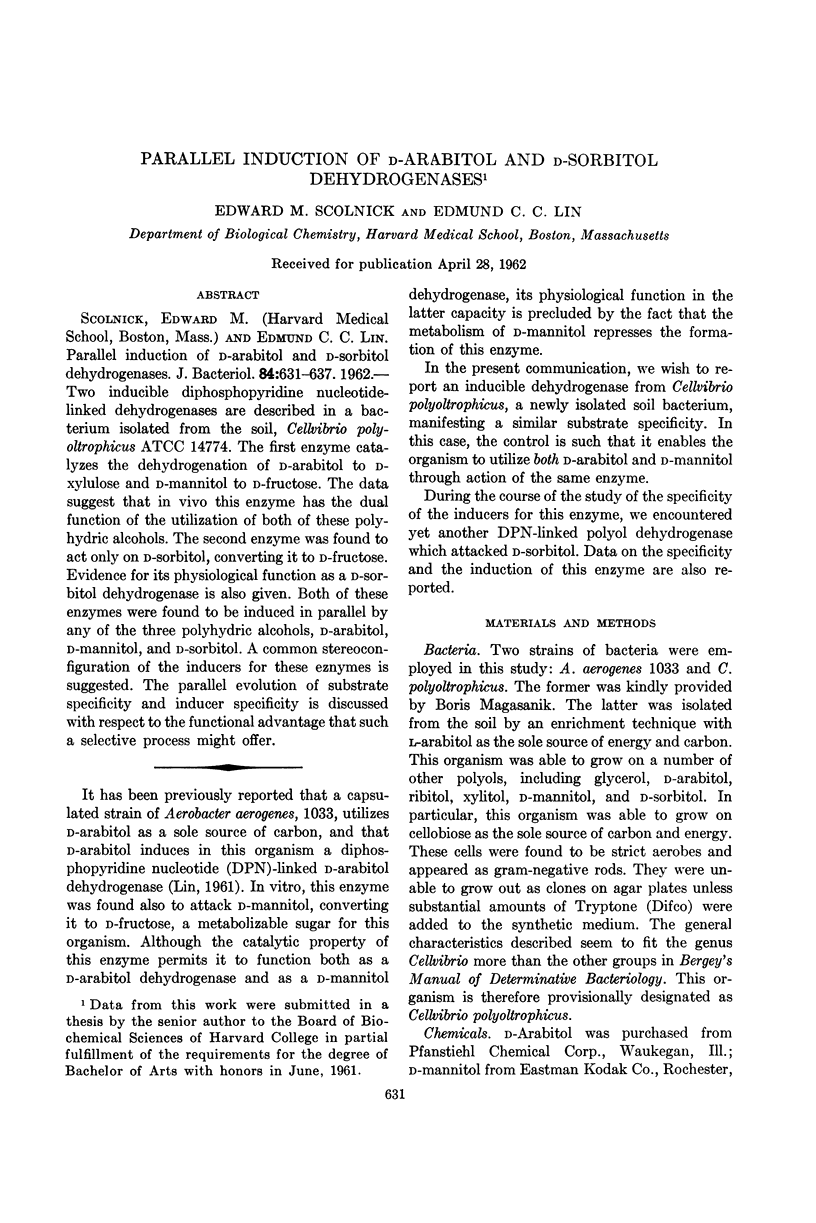Abstract
Scolnick, Edward M. (Harvard Medical School, Boston, Mass.) and Edmund C. C. Lin. Parallel induction of d-arabitol and d-sorbitol dehydrogenases. J. Bacteriol. 84:631–637. 1962.—Two inducible diphosphopyridine nucleotide-linked dehydrogenases are described in a bacterium isolated from the soil, Cellvibrio polyoltrophicus ATCC 14774. The first enzyme catalyzes the dehydrogenation of d-arabitol to d-xylulose and d-mannitol to d-fructose. The data suggest that in vivo this enzyme has the dual function of the utilization of both of these polyhydric alcohols. The second enzyme was found to act only on d-sorbitol, converting it to d-fructose. Evidence for its physiological function as a d-sorbitol dehydrogenase is also given. Both of these enzymes were found to be induced in parallel by any of the three polyhydric alcohols, d-arabitol, d-mannitol, and d-sorbitol. A common stereoconfiguration of the inducers for these enzymes is suggested. The parallel evolution of substrate specificity and inducer specificity is discussed with respect to the functional advantage that such a selective process might offer.
Full text
PDF






Selected References
These references are in PubMed. This may not be the complete list of references from this article.
- Ames B. N., Garry B. COORDINATE REPRESSION OF THE SYNTHESIS OF FOUR HISTIDINE BIOSYNTHETIC ENZYMES BY HISTIDINE. Proc Natl Acad Sci U S A. 1959 Oct;45(10):1453–1461. doi: 10.1073/pnas.45.10.1453. [DOI] [PMC free article] [PubMed] [Google Scholar]
- DE ROBICHON-SZULMAJSTER H. Induction of enzymes of the galactose pathway in mutants of Saccharomyces cerevisiae. Science. 1958 Jan 3;127(3288):28–29. doi: 10.1126/science.127.3288.28. [DOI] [PubMed] [Google Scholar]
- Gale E. F. FACTORS INFLUENCING THE ENZYMIC ACTIVITIES OF BACTERIA. Bacteriol Rev. 1943 Sep;7(3):139–173. doi: 10.1128/br.7.3.139-173.1943. [DOI] [PMC free article] [PubMed] [Google Scholar]
- KAPLAN N. O., CIOTTI M. M., HAMOLSKY M., BIEBER R. E. Molecular heterogeneity and evolution of enzymes. Science. 1960 Feb 12;131(3398):392–397. doi: 10.1126/science.131.3398.392. [DOI] [PubMed] [Google Scholar]
- KOPPEL J. L., PORTER C. J., CROCKER B. F. The mechanism of the synthesis of enzymes. I. Development of a system suitable for studying this phenomenon. J Gen Physiol. 1953 May;36(5):703–722. doi: 10.1085/jgp.36.5.703. [DOI] [PMC free article] [PubMed] [Google Scholar]
- Kalckar H. M., Kurahashi K., Jordan E. HEREDITARY DEFECTS IN GALACTOSE METABOLISM IN ESCHERICHIA COLI MUTANTS, I. DETERMINATION OF ENZYME ACTIVITIES. Proc Natl Acad Sci U S A. 1959 Dec;45(12):1776–1786. doi: 10.1073/pnas.45.12.1776. [DOI] [PMC free article] [PubMed] [Google Scholar]
- LESTER G. The beta-galactosidase of lactose mutants of Escherichia coli, K-12. Arch Biochem Biophys. 1952 Oct;40(2):390–401. doi: 10.1016/0003-9861(52)90127-6. [DOI] [PubMed] [Google Scholar]
- LIN E. C. An inducible D-arabitol dehydrogenase from Aerobacter aerogenes. J Biol Chem. 1961 Jan;236:31–36. [PubMed] [Google Scholar]
- LIN E. C., LEVIN A. P., MAGASANIK B. The effect of aerobic metabolism on the inducible glycerol dehydrogenase of Aerobacter aerogenes. J Biol Chem. 1960 Jun;235:1824–1829. [PubMed] [Google Scholar]
- MAGASANIK B., NEIDHARDT F. C. Inhibitory effect of glucose on enzyme formation. Nature. 1956 Oct 13;178(4537):801–802. doi: 10.1038/178801b0. [DOI] [PubMed] [Google Scholar]
- MONOD J., COHEN-BAZIRE G., COHN M. Sur la biosynthèse de la beta-galactosidase (lactase) chez Escherichia coli; la spécificité de l'induction. Biochim Biophys Acta. 1951 Nov;7(4):585–599. doi: 10.1016/0006-3002(51)90072-8. [DOI] [PubMed] [Google Scholar]
- PORTER C. J., HOLMES R., CROCKER B. F. The mechanism of the synthesis of enzymes. II. Further observations with particular reference to the linear nature of the time course of enzyme formation. J Gen Physiol. 1953 Nov 20;37(2):271–289. doi: 10.1085/jgp.37.2.271. [DOI] [PMC free article] [PubMed] [Google Scholar]


